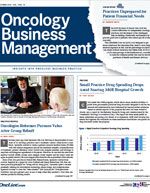Publication
Article
Special Issues
Playing Field Tilted Against Small Practices
Author(s):
Bruce J. Gould, MD, shares his experience as a private oncology practitioner facing competition from large medical centers with respect to 340B drug pricing.
Bruce J. Gould, MD
What has been the impact of the 340B Drug Pricing Program on private oncology practices in the community?
How does this impact patient care?
Average Daily per-Patient Medicare Fee-For-Service Payments, Part B Oncology Drugs
Source: Copyright (C)2015 by the Berkeley Research Group, LLC. “340B Growth and the Impact on the Oncology Marketplace.”
Are payers responding to this emerging trend with 340B?
What are your thoughts on the COA report highlighting 340B drug spend that was released in September?
Do you see a resolution to this issue?
In this interview, Bruce J. Gould, MD, who is the medical director of Northwest Georgia Oncology Centers in Marietta, GA, shares his experience as a private oncology practitioner facing competition from large medical centers with respect to 340B drug pricing. He praises the newly issued Berkeley Research Group report, commissioned by the Community Oncology Alliance (COA), on unbridled growth of the 340B program. The report found that Medicare Part B cancer drug spending rose 123% in 340B hospitals from 2010 to 2013 and fell 5% in community practices during the same period.Gould: I am in the Atlanta metro area where we have about 120 to 130 oncologists—about 90 or so are now based in hospitals and 60 or so of them are in hospitals that are 340B-based. As a private practice competing against a group of oncologists centered in a hospital that has 340B pricing is an unlevel playing field because we are competing based on what services each group provides. We are competing based on who has the deepest pockets. Obviously, in this case, the hospital-based group has deeper pockets—they can hire my employees and doctors by providing them with better salaries. In communities where we overlap, especially in smaller communities where there may not be enough business for 2 separate practices, they have been able to drive us out of the market place because they have more sustaining power, again due to the deeper pockets, while private practices have to rethink sustainability options to stay within the community.Gould: First, especially in smaller communities, where there used to be 2 choices now there’s only 1. So, a patient who’s dissatisfied with the care at one practice does not have the choice to go to another one. Second, physicians are being enticed to go to the hospital because of higher compensation and, whether the hospital has 340B pricing or not, patients are faced with higher copays and higher costs to payers, which ultimately drives up healthcare costs and results in raised premiums for all of us.Gould: Yes, finally! This trend has been going on for at least 5 to 6 years now and, unfortunately, in my opinion, payers have been very slow to recognize this trend and how much it’s been costing them. But finally, they have awakened to the fact within the past year that there are higher costs involved with care in hospitals versus in private practices. They are now trying to work with us in terms of doing innovative projects and they are also finally increasing our fees whereas over the past few years they had cut our fees. Payers are now doing more to sustain private community oncology practices.Gould: The thing that impressed me was how well the study was conducted. The growth in the 340B program was studied in a very distinct manner—for the denominator, they looked at the hospital outpatient drug spend rather than what a lot of the reports include, which is the hospital’s entire drug spend. Looking at the hospital’s entire drug spend [when evaluating 340B spending] is not really appropriate because 340B applies only to the hospital outpatient drug spending and considering the entire drug spend would underestimate the actual numbers. And COA even looked at how much of the 340B spending is on oncology drugs and surprisingly a majority is oncology drug spend. This speaks to the fact that hospitals are quite actively recruiting oncologists rather than rheumatologists or infectious disease doctors. This has also resulted in a shift in the site of care, which is of interest to COA. Second, in this study, all the typically used oncology drugs were accounted for. The earlier report by the Government Accountability Office (GAO) left out the top 6 oncology drugs because they did not want to account for these 6 drugs having orphan drug indications. So GAO, in its report, left out a large part of the drug spend. The COA report erred on the other side and included these drugs which account for a significant portion of the 340B spending.Gould: Well, there’s a lot of interest in trying to rectify this. But my personal opinion is that I am not sure if it will ever be reformed because clearly there are hospitals that have a large interest in keeping the program as is and they have strong lobbying groups. It’ll be a push-pull between the pharmaceutical industry and the hospitals on who will sway the decision makers in Washington, DC, in terms of who gets the regulations changed in their favor.

























%20(2)%201-Recovered-Recovered-Recovered-Recovered-Recovered-Recovered-Recovered-Recovered-Recovered-Recovered-Recovered-Recovered-Recovered-Recovered-Recovered-Recovered-Recovered.jpg?fit=crop&auto=format)
%20(2)%201-Recovered-Recovered-Recovered-Recovered-Recovered-Recovered-Recovered-Recovered-Recovered-Recovered-Recovered-Recovered-Recovered-Recovered-Recovered-Recovered-Recovered.jpg?fit=crop&auto=format)
